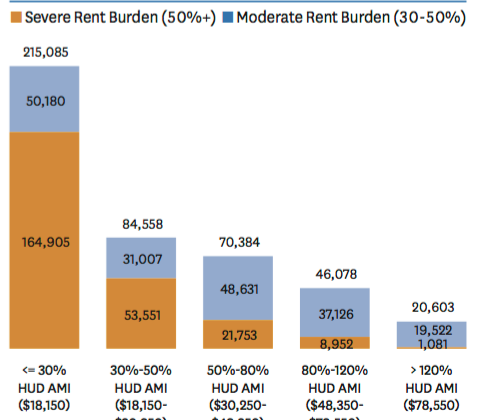We Support Proposal to Increase Funding for DOC Housing Voucher Program
The Washington State Department of Corrections (DOC) has housing voucher program that offers qualifying people leaving state prisons $500 per month for rent to help them transition back into regular life. A study by Washington State University in 2013 found the program to be very effective in reducing the costs associated with keeping people in jail past their release date and reducing recidivism and homelessness. The legislature is considering SB 5441 that would increase funding for the program.
The study found that,
Housing vouchers represent an efficient alternative to incarceration that can reduce costs and increase offender reintegration with few discernible drawbacks to public safety, as compared to current standard practices.
Recently proposals to “Ban the Box” have been offered as a solution to the very real struggle people with criminal records have getting housing. These proposals would prohibit people renting housing from considering a person’s criminal record when renting them housing.
“Ban the Box doesn’t work,” said Roger Valdez, Director of Seattle For Growth. “For most people releasing from the state’s prisons credit problems, poor tenancy history, and lack of employment will still make getting a place to live difficult. The DOC’s voucher program is a real answer, giving people coming out of the system a real resource and help to get back on their feet. But 3 months isn’t often long enough.”
“The program is efficient and compassionate and should get more resources,” he said.
The proposal is consistent with the City of Seattle’s Housing Affordability and Livability Agenda (HALA) Recommendations. Section T1 of that document said this:
The City should pursue a combination of local legislation, education, and technical assistance to ensure fair access to Seattle’s housing options for people with criminal records. Any legislation should provide fair access to people with criminal records yet protect property owner’s rights and interests.
Seattle For Growth agrees.
Seattle For Growth has urged the legislature to:
- Extend the voucher to 12 months;
- Appropriate funding for the program based on past years; and
- Create an allowance for an adjustment of the vouchers based on Fair Market Rents like section 8
Extension without funding won’t do all that much. And for more expensive markets there ought to be an allowance to mirror the rent structure in the Section 8 program. The study found that many participants no longer need the voucher after they gain employment, so not all participants would need a full 12 months. The legislature should also consider incentives to encourage participation from people who rent apartments and own and operate rental housing.
Seattle For Growth Position Paper
Some Progress in Olympia: Senate Bills 5361 and 5441
There is a little bit of good news to report. We are grateful to Senator Hans Zeiger for sponsoring Senate Bill 5361, legislation that would enact recommendations of the Joint Legislative Audit Committee’s (JLARC) review of the differences between the costs of building non-profit and for-profit housing. The bill would require more cost reporting (something we asked for last session) and would require a look at how increase for-profit developer participation in tax credit projects. You can read the tex of the bill here: http://lawfilesext.leg.wa.gov/biennium/2019-20/Pdf/Bills/Senate%20Bills/5361.pdf
We are also appreciative of Senator Joe Nguyen who has sponsored legislation, Senate Bill 5441, to extend the Early Release Voucher from 3 months to 6 months. The ERV program is run by the State Department of Corrections and gives qualified people leaving prison a voucher for three months. We think the voucher should be extended to at least 12 months with full funding. You’ll remember that Seattle For Growth has been an advocate of this program and extending the voucher for years. You can read the text of the bill here: http://lawfilesext.leg.wa.gov/biennium/2019-20/Pdf/Bills/Senate%20Bills/5441.pdf
These bills represent some progress in Olympia for efficiency in the housing subsidy system, something we’ve advocated for a long time. We need to reduce costs, and that may mean allowing for-profit builders to build affordable housing And helping people leaving prison with rent is much more important and helpful than more rules and regulation. Remember, efficiency is compassionate.
Martin Luther King: “Somewhere I Read….”
If you find this post useful, consider a contribution to our work today.
Martin Luther King was a man of words and action. I’m ambivalent about the official holiday celebrating his life and work. Is he worthy of the honor? Of course. But I worry that the dominant culture may have used the holiday to tame and commodify a radical legacy. King was not as radical or extreme (a matter of perspective) as some of his colleagues, but his message was a profoundly challenging one. In my years in the housing world I’ve seen a dangerous and detestable appropriation by the dominant culture of the suffering and struggle of poor people of color. Here’s what I wrote to a colleague a while back about this:
The rules for engagement on race in this town need a rewrite, although I know they’re unwritten. Absolutely race is a real factor, and racism is something that does actual damage to real people physically, socially, psychologically, and economically. But I see a sort of secondary damage being done when the real harm of racism is appropriated by enfranchised, privileged white people as a basis to protect themselves.
I mean when the white homeowner in Columbia City says, “all this new growth is hurting people of color by gentrifying the neighborhood. And our city is segregated!”
A nonsensical grab bag argument to protect their own asset, oddly, at the expense of the realities of racism. It’s as if all that racism is being cashed in by the homeowners to make the argument that nothing should change. Why shouldn’t we build more housing in Columbia City? Racism? Oh. Ok. The dominant culture commits acts of racism, then uses the suffering of racism to protect itself. Nice work. And the final straw that breaks my camel’s back? When Rebecca Saldana is the one saying those things. The circle, as they’d say, is complete. Racism, then racism used by whites to protect themselves, then that protective use given an ethnic voice. Mean? Maybe. The truth. Unfortunately I think so.
So you, as a person of color, can make that distinction clear. Yes, there is racism. No, [fighting racism is] not about protecting [someone’s] million dollar home, it’s about doing what we can to undo the damage done and make sure we limit it in the future. Hard to do in a campaign context, but it’s what we should strive to do to keep us sane.
There is nothing more outrageous that seeing suffering turned into a talking point, and scarcity of an essential, like housing, twisted into the basis for an embargo. My favorite passage of King’s final speech I call, “somewhere I read.”
All we say to America is, “Be true to what you said on paper.” If I lived in China or even Russia, or any totalitarian country, maybe I could understand some of these illegal injunctions.
Maybe I could understand the denial of certain basic First Amendment privileges, because they hadn’t committed themselves to that over there.
But somewhere I read of the freedom of assembly.
Somewhere I read of the freedom of speech.
Somewhere I read of the freedom of press.
Somewhere I read that the greatness of America is the right to protest for right.
I can imagine an adaptation for Seattle.
All we say to Seattle is, “Be true to what you said on paper.” If I lived in Oklahoma or even Alabama, or any place that was full of climate deniers and racists, maybe I could understand some of these drastic measures taken against housing production.
Maybe I could understand the redlining of the Rainier Valley and Central District, and calling it a “low opportunity area,” in the name of protecting the people who live there from “displacement”
But somewhere I read about the Growth Management Act.
Somewhere I read that we’d grow both housing and opportunity in our cities.
Somewhere I read that Seattle is a Sanctuary City.
Somewhere I read that Seattle is “a welcoming city.”
I often hear his voice when I see an angry mob of mostly white single-family homeowners railing against new housing.
I hear him saying, “Somewhere I read. Somewhere I read.” Then I remember his call to strength in the face of that mob.
And so just as I say, we aren’t going to let dogs or water hoses turn us around, we aren’t going to let any injunction turn us around.
He calls us not to let the rules and regulations and taxes and fees and slurs “turn us around.” I hope we’ll heed that encouragement as we work to build more housing of all kinds, in all parts of the city, for people of all levels of income.
Micros Are More Affordable With Many Benefits to Low Income Renters
Ari Webb has been digging into the research literature about unit size and costs. This is a second entry in his review and analysis of what we’ve learned over the last decade about affordability, efficiency, and unit size.
A recent trend has emerged in the American housing market: the trend towards micro apartment units. There is no consistent definition of a micro unit, however, micro units are generally accepted to be small living spaces that are “typically less than 350 square feet, with a fully functioning and accessibility compliant kitchen and bathroom”. The recent introduction of micro units to the housing market is probably due to multiple market forces, including increased demand for housing in growing urban centers.
With the size limiting trend has come national discussion regarding how micros, or micro units, should be integrated into the housing market. In the context of America’s current housing crisis, discussion of micros always seems to come back to one main idea: affordability.
Some critics of micro units believe that they do not address housing affordability. This notion is based on a misinterpretation of data. In reality, micro housing offers an innovative solution to urban housing affordability. Further, micro housing offers numerous advantages to low-income renters.
Critics of micro housing believe that they may not be affordable, a notion that rests on one misleading idea: that micro housing cost more to rent per square foot. Skeptics of micro housing affordability draw attention to higher per square foot costs, saying that “less space doesn’t necessarily mean less cost… on a square foot basis [micro units] are almost always more expensive than other apartments”.
The idea of higher rent per square foot in micro units has been substantiated by research. Per square foot rents are, in most cases, higher in micro units. However, the consideration of per square foot metrics is distracting, as higher rent per square foot does not imply higher gross rent.
In fact, the truth is quite the opposite. The truth can be explained by a recent Portland State University reportthat explains that “because [micro units] have dramatically less square footage than conventional units, their gross rent is lower.” This trend is shown well by data from the Sightline Institute showing average monthly rent per square foot of apartments in the greater Seattle Area.
 Smaller unit sizes definitely correlate with lower rents. David Neiman, a Seattle architect and writer about micro housing explains this trend perfectly:
Smaller unit sizes definitely correlate with lower rents. David Neiman, a Seattle architect and writer about micro housing explains this trend perfectly:
The figure shows that average apartments of fewer than 200sf rent for $868 a month, on average… They rise to almost $2,200 a month for a large apartment of 1,450 to 1,500sf. Because these figures span parts of three counties and mix new and old apartments, they underestimate the price escalation by size in urban markets, where units are smaller and space costs more… Anyone in the housing business will agree that rents and size rise in lockstep, all else being equal.
This common knowledge debunks the idea that rent per square foot measurements even matter. Who cares if rent for micro units is more per square foot? If the units are less costly overall, then they are, by definition, more affordable. Further, the increased affordability of micro units gives numerous advantages to lower income renters.
One such advantage is increased access to neighborhoods. Many micro units are built in “high-rent, high-amenity urban neighborhoods”: neighborhoods that low income renters would otherwise be unable to move to. Micro housing offers economic opportunity to low income renters through giving them better access to economic prosperity in wealthy neighborhoods. Improved location also allows for increased access to public transit.
Another advantage of micro units is that they cater better to a changing demographic of renters. A 2014 study by the Furman Center at New York Universitycontended that current housing supply does not effectively reflect a changing pool of renters.
At all income levels, today’s households are much more diverse, and more fluid in composition than the prototypical nuclear family of the 1950s. Household sizes have shrunk, people are waiting longer to marry… more people are living alone, more people are sharing housing with unrelated relatives
This is not to say that low-income families are not important. The point is that many people benefit greatly from the affordability of micro housing (more on this can be found on my other blog post).
I encourage policymakers to be aware that size does matter. Smaller unit sizes mean smaller rents. The trend towards smaller unit sizes is very helpful for the affordability of housing in dense urban areas. Affordability gives numerous advantages to low-income renters, including economic opportunity through being able to live in otherwise inaccessible neighborhoods and offering options that better fit a changing renter demographic.
Ari Webb is a high school student who is interested in public policy, especially the Seattle housing crisis and believes that increasing housing supply is the most effective way of extending affordable housing to people of all income levels
An Answer to Stabilizing Rental Markets: Unit Size
Imagine a young adult, fresh out of college and entering into the housing market for the first time. She needs to live close to transit for an internship opportunity downtown, but she is cash strapped. She cannot afford the market rate $1,500 for a studio apartment. She is willing to sacrifice square footage for better affordability, but due to regulation, there are no such housing options. What should she do?
This hypothetical situation is not too uncommon in large urban areas. A study from the Furman Center at NYU found that, “In 2015, more than 436,000 single adults who lived alone in [New York City] were rent burdened, meaning they spent more than 30 percent of their income on rent.” This data shows a clear disconnect between the price of the housing that is available and the financial capabilities of renters. For lower income renters, who rent small units or have roommates at high rates, this disconnect is especially painful. This is due to the fact that there are “a total of only 210,000 small units, in comparison to the nearly 1.2 million renters living alone or with unrelated roommates in the city.”
So what is the solution to this dilemma? Would allowing the construction of smaller units truly help this rent crisis? Some people may argue that smaller units won’t help the market, as units are already trending towards smaller sizes, yet rents still continue to increase. I disagree. Financial modeling published as part of the Furman Center study concluded that constructing smaller units does, in fact, lead to less rent. This financial modeling compared studio apartments to micro units and efficiency unit models. It found that construction of smaller units definitely helps with rent burden.
A small studio unit requires rent of approximately $1,480 per month to support construction… an efficiency unit with shared kitchen and bath would require a rent of approximately $840 per month.
It is important to acknowledge that not all people struggling with housing costs are single people who are able to live in small units. But as the Furman study shows, the number of people who are single and can benefit is large and significant. Allowing the market to solve this segment’s problem means they won’t need subsidies and that means those dollars can help families and other who have different needs.
It is true that recently, rental square footage has gone down, on average, while rents have gone up. But this is a macroeconomic measurement. Such a measurement is very broad and ignores the fact that due to other market forces, rents would probably be even higher if units had stayed at the same size. Policymakers nationwide should know how much smaller units could help the market as they contemplate how to solve the current affordable housing crisis; They should be aware of the monumental impact smaller units can have on rent affordability and the stabilization of the rent market.
Ari Webb is a high school student who is interested in public policy, especially the Seattle housing crisis and believes that increasing housing supply is the most effective way of extending affordable housing to people of all income levels.




